When it comes to the basic input devices, most consumers are familiar with the traditional mouse and keyboard. If they are a little more adventurous, or professional for that matter, they might make use of a trackpad, or a stylus-enabled drawing pad.
But there is another input device that escapes the mind of most consumers when they think of input devices. And yes, that is the humble trackball mouse. So today, we present to you the best trackball mouse money can buy.
Whether you are in the market for one, or just simply interested in finding out more about these mice, we sourced the best available models in the market and funneled them down into a handy list.
Table of Contents
The Best Trackball Mouse Review
We simply took into account the factors that are important to you, the end consumers, and structured out the article in a manner that best presents those factors. So, grab your food, get comfortable, and have a read.
1. Logitech M570 Wireless Trackball Mouse
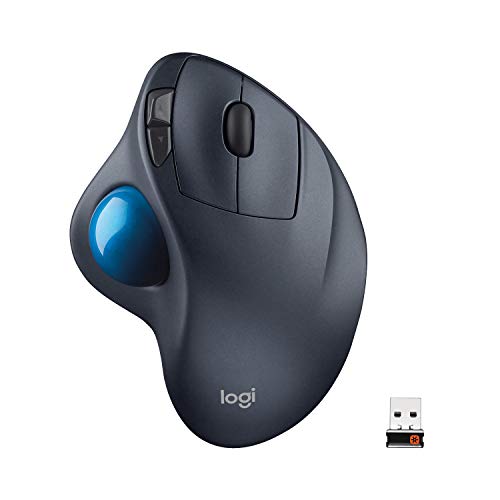
First up on our reviews list, we have the M570 from Logitech. We highly recommend this particular mouse if the MX Ego is out of your budget. This mouse also serves as a very good, and cheap, introduction into the world of trackball mice. And this variant costs about 1/4th as much as its successor.
But it still remains a very solid option. Now, against the MX Ergo, it might feel a little cheap, plus it lacks the MX Ergo’s tilt feature. Still, if you feel you can forgo the Bluetooth connectivity and the extra buttons, the Logitech M570 is a very viable option.
Taking a deeper dive into the mouse, the trackball is the same dimensions as the MX Ergo. The smoothness is on par, and the ball is quite easy to rotate around. And the buttons are all tactile and feel quite nice.
Like the MX Ergo, the M570 is also made out of plastic and includes a tiny divot on which you can rest your pinky. The surface is covered in a smooth plastic. Now, this design can look a little outdated at times, but the unit overall is much lighter than other products.
Let us talk a fair bit about the companion software. In order to use the mouse to its full potential, you ought to have the companion software installed. The software to use is the Logitech control center. And the Logitech Options, a much newer software, does not include the M570 on the list of mice it is compatible with.
The interface is fairly outdated, and it does not include the Logitech Flow feature. But hey, it is pretty much nitpicking considering the price the M570 commands. You can expect over 15 months of battery life out of the AA batteries when using the M750, very close to Logitech’s claim of 18 months.
Pros
- Impressive battery life
- Lightweight and comfortable to use
- On/off button to further conserve battery
- The ball is smooth and balanced well
Cons
- Outdated design and software
2. Kensington Expert Wireless Trackball Mouse
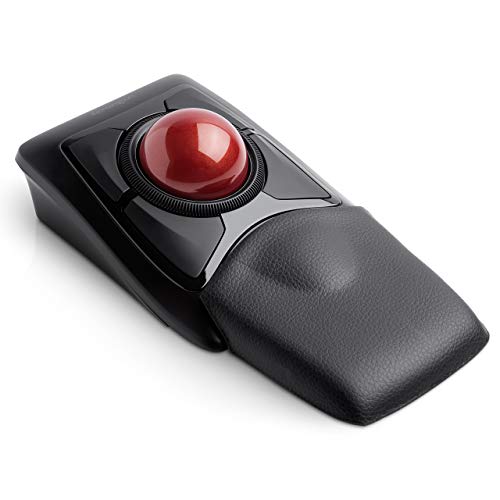
Looking for that high performance and ergonomics package? The K72359WW Expert from Kensington is the one you are looking for. This is one of the best finger-operated overall trackball mice you can buy right now. The trackball is large and smooth, and the design is ambidextrous.
And the four buttons on the surface are easy to customize with the companion software. The mouse itself supports wireless connectivity, either by the dongle (2.4GHz) or by Bluetooth.
Let us talk about the trackball. The Expert’s trackball is the biggest of all the trackball mice we have covered in our reviews. Big and dense, the ball rotates smoothly. Due to the large size, it is much easier to move the cursor in high definition or multiple display setups. Removing the ball is as simple as pulling it out.
We do recommend taking the ball out once in a while for routine cleaning. And we are not too sure about the brand of switches they are using in the buttons, but we cannot complain either. They feel great with excellent response times.
Now there is a scroll ring around the trackball. It serves the same purpose as the scroll wheel on a normal, traditional mouse, that is to say, we can use it to scroll up or down. It feels a little janky as if the ring is constantly catching on something. The resistance did not give away after a week of use.
Kensington included a wrist rest in the box. This is entirely up to the user, whether or not to use the wrist rest. Our testing found that the wrist rest, although occupied a substantial amount of desk real estate, made the trackball mouse significantly more comfortable to use.
Moreover, we did mention that the mouse is ambidextrous. You can use it with both your left or right hand. The mouse is finger-operated, not restricted to just the thumb. And thus, you are not forcing your hand into a singular mouse, as other thumb-operated trackball mice do.
Pros
- Supports wireless connectivity
- The largest trackball in this segment
- Includes a scroll ring
- Ambidextrous design
Cons
- Takes up a lot of desk space when used with the optional wrist rest
3. Logitech MX Ergo Wireless Trackball Mouse

Looking for the best thumb-operated trackball mouse? Then do not look past the Logitech MX Ergo Wireless Trackball Mouse. The direct successor to the MX 570 we discussed previously in our article, the MX Ergo improves on a lot of fronts over its predecessor.
Let us take a deeper dive into its base feature, that trackball. At 34 mm, the gray trackball is smaller than both the Kensington Orbit and the Expert trackball mouse but is of the same dimensions as its predecessor, the MX 570. We do need to put in a fair bit more effort to move the cursor around.
The ball can be removed by driving a toothpick through a tiny hole on the underside (flip it) of the mouse. Button-wise, the MX Ergo comes with a whopping 8 button configuration, almost twice that of the Kensington Expert and about 3 more than Logitech’s own MX 570. The buttons are all tactile and responsive.
Also, the companion software, the Logitech options, has all the features and settings we will ever need to make the most out of the 8 buttons layout of the MX Ergo. A single charge of the battery should see you through at least 4 months, though we reckon we can get a lot more out of it through conservative usage.
As for connectivity, the Logitech can be connected to your Mac or the PC wirelessly either by Bluetooth or by using the included Unifying dongle. The Ergo improves on the scroll wheel department over the MX 570. And the new and improved scroll wheel is clicky and can be tilted on either side.
Furthermore, the MX Ergo comes with a stand that you can use to prop up the body of the mouse to an orientation of your liking. The stand itself is magnetic, and you can use it to incline the mouse to 20 degrees.
Pros
- The design is comfortable to use
- Comes with a magnetic stand for easy propping
- The tracking is quite accurate
- Bluetooth connectivity and Unifying dongle
Cons
- The unit is not ambidextrous
4. Kensington Orbit Trackball Mouse with Scroll Ring
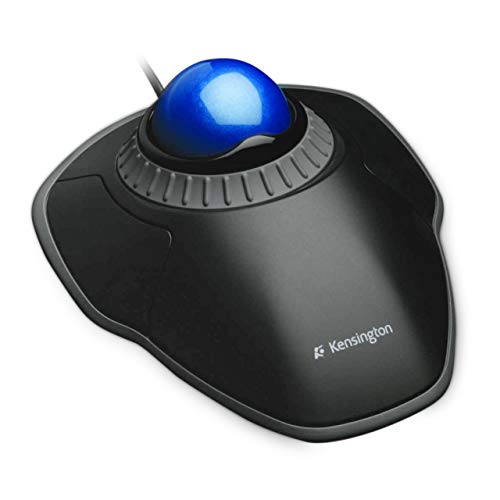
Want to get into Kensington and scroll rings, but on a tight budget? We have you covered. Introducing the Orbit trackball mouse with scroll right from Kensington. The Orbit has a smaller trackball and comes with only two buttons, but it makes up for it through its cost-effectiveness and strong feature set.
This is also one of those models that we recommend to those of us who are just getting into the expansive world of trackball mice. The learning curve flattens out with a simple-to-use mouse like this one. And the connection is wired, so we need not worry about the battery juice draining out.
Dimensions-wise, it is much flatter than the Kensington Expert mouse, which is a good thing. A flatter surface is generally more comfortable for newbies, veterans alike. The scroll ring, a feature we see in most Kensington trackball mice, makes its appearance on this model too. And the rotation speed is a little slower than the others.
Let us take a small peek at the trackball. The trackball used in this variant is a little smaller than that used in the Expert mouse but fairly bigger than that used in the Ergo. And the model can be sent in for cleaning in the same way as the expert mouse. Just take the ball out and clean away.
The buttons feel cheap to the click. We feel that Kensington could have provided a little more decent feeling switches on these. Although the overall construction is of plastic, it does feel substantial. The plastic itself felt soft to the touch, and the unit weighs in at 144 g.
Now, this particular trackball mouse makes use of a singular red optic sensor that helps the mouse to detect the slightest of movements on the trackball. The trackball is accompanied by our two right and left mouse buttons on either side.
Unlike the critically acclaimed Kensington Slimbade, there are no additional buttons to be had on this unit. Though, a point of note, it is possible to assign a command for both the right and left mouse buttons being pressed simultaneously. This is done through the Kensington companion software available for download.
Many of us do not appreciate the cables. Cable management is a big, big problem, especially in tight spaces. The Orbit uses a USB cable as its connection. We wish this model came in a wireless variant.
Pros
- The design is ambidextrous in nature
- Inclusion of a scroll ring
- Uses Optical Tracking technology for superior tracking
- Competitively priced
Cons
- The included wrist rest is fairly useless
5. Logitech Trackman Marble Trackball Mouse
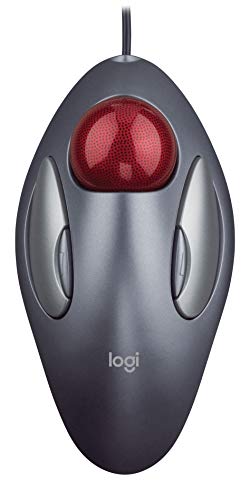
Now we are going to take a look at an ambidextrous offering from Logitech, the Trackman Marble. This is one classic mouse we have on our list. And this unit made its mark on history way back in 2004 and still in production today. We are sure that this fact alone speaks volumes about how good this mouse is.
So, one of the first things you notice is the lack of any visible scroll wheel. Disbelief? Sure. A mouse without a scroll wheel in this decade? You must be out of your mind, dear editor, to include a mouse without a scroll wheel – is what we would think too. But bear with us.
The lack of a scroll wheel can be addressed via the companion software. It can be set such that holding down one of the buttons, and then rotating the ball turns the ball into a scroll ball.
True, it is not as convenient as having an actual scroll ball or a scroll wheel, but we must remember that this unit is from 2004, and must be treated as such. The trackball itself is not the largest on our list, but it is still quite large. And the buttons are quite tactile.
Without installing the companion software, the button layout is as follows. The two big buttons serve as the right and left buttons. And the two smaller buttons are basically the browser page forward and backward button. There is no middle click button, obviously, due to the lack of a scroll wheel.
Moreover, the unit doesn’t come with any onboard storage. That means we have to keep the Logitech software running if we make any customizations. But the winning feature about this trackball mouse would be that trackball. Like we said earlier, it is not the biggest, but it is very smooth to the touch and feels very, very premium.
You do not need the companion software to get this unit running out of the packaging. But if you want to set up that scrolling feature, it might be for the best to have it installed. The name of the companion software is Logitech Trackman Marble SetPoint. And the interface is not the best, but hey, it works.
Pros
- That trackball feels great to the touch
- Ambidextrous design
- The buttons are tactile
- It does not require any setup to get up and running
Cons
- No scroll wheel or scroll right, but it still gets a pass from us
6. ELECOM M-HT1DRBK Wireless
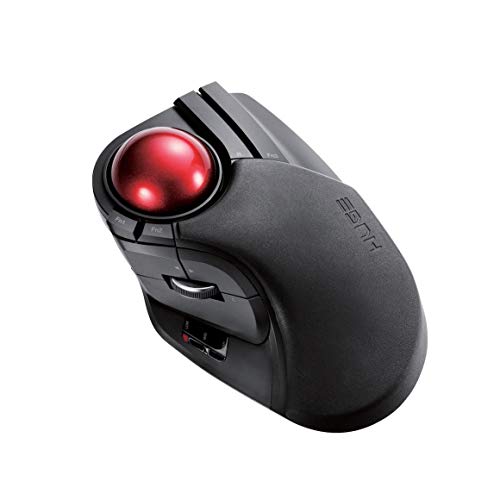
Now, we use trackball mice for the higher levels of accuracy that they offer, or because we have a small surface to work on. They are made on the grounds to reduce, if not eliminate, RSI as a whole. That, however, is not achieved on some trackball mice, to be more specific, the thumb-operated trackball mice.
Rapid thumb movement can be linked to RSI. On the other hand, there is a steeper learning curve to using these thumb-operated trackball mice. That is where the M-HT1DRBK Wireless from Elecom comes in. The ball is transferred to the top of the mouse, and it is meant to be used with your index finger.
So, how does it stack up to the competition? Let us start with the design. The M-HT1DRBK Wireless seems like something straight out of a sci-fi movie. And the bright red ball, the stark black body seems to work quite well with each other. The color scheme reminds us of those Red Hydrogen cameras, and that is not a bad thing.
Despite its 90s movies color scheme, the shell looks quite modern, and the button layout further adds to that aesthetic. The mouse comes with 8 buttons and has all the features and tricks to impress the hardiest of macro users. And the second thing that comes to mind is the size of this thing. It is quite massive.
This is not something you quite notice until you pick it up with your hands. Despite its outlandish size, we feel that it is still quite controllable by hands of various sizes. The buttons are long and can be actuated with the mildest of clicks. And the two main important controls to any mouse would be the left and right clicks.
While on a traditional mouse, your index finger would be controlling the left click, here your index finger moves the trackball around. On this mouse, you operate the left button using your thumb.
It is still business as usual for the right-click. You use your middle finger to control the right button. Your ring finger operates the 3rd of the function buttons. As we said, the learning curve for this mouse is not steep at all.
Moreover, the mouse weighs in at a hefty 112 grams. This is quite apparent when you have a feel of the mouse.
Also, it is very solidly built, with the trackball rotating smoothly. The smoothness is on par with some of the more expensive models we have featured on our list, which is surprising given that this is an entry-level Bluetooth model.
Pros
- Multi DPI Settings; switch from work to play with a single press
- High responsiveness
- Includes a scroll wheel like a traditional mouse
- Feels very premium in the hands
Cons
- Can be a little heavy and cumbersome
7. ELECOM M-XT4DRBK Wireless Trackball mouse for Left-Handed
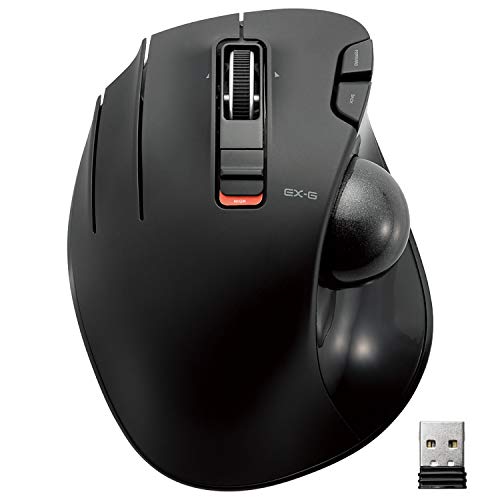
Yes, yes, we included quite a few ambidextrous mice on our review list. But it would feel incomplete if we did not include a mouse exclusively for left-hand use. Introducing the ELECOM M-XT4DRBK Wireless Trackball yet again, but this time for left-handed use.
Well, for starters, we begin by stating that the Elecom M-XT4DRBK for left-handed people is the mirror image of the unit meant for right-handed people. And that is about it. The product is the same throughout.
So, we are going to go about by discussing the unit in further detail. The discussion, do note, applies to both left-handed individuals and the right-handed ones. Like we have discussed before, one of the advantages of using a trackball mouse is that it greatly increases accuracy.
The M-XT4DRBK comes with a switch that helps us choose from a set number of DPIs. They are in increments of 500, so they are basically at 500, 1000, or 1500 DPI. For daily routine tasks, we recommend keeping the DPI at the 500 DPI mark.
For a little more professional work, like using Premiere or Photoshop, we recommend upping your monitor’s resolution and increasing the DPI sensitivity. One, this helps scale up the sensitivity for movement. Two, it helps increase the rate of detection. So, the more subtle movements in the trackball can now be detected.
And the scroll wheel is quite delightful to use. Clearly, the makers of this mouse listen and know what is where. The scroll wheel is very, very precise, and the tactile feedback is one we would compare to eSports grade gaming mice. It is just that good.
Much like the best of the best, highest-end gaming mice, the switches used in main buttons are from OMRON. They are the household name in making switches with the tactility response comparable to that of mechanical keyboards.
Moreover, they are not loud by any means when you compare them to the switches of a standard mouse, but the tactility in every click is more apparent as you click. Sounds pretty complicated, right? Trust us when we say this, you will want to pick up one of these bad boys after having a good feel of them.
Pros
- A mouse for left-handed people
- They use OMRON switches
- The scroll wheel is an absolute delight to use
- The DPI is three-stage adjustable
Cons
- We could not find any
8. Kensington SlimBlade Trackball Mouse

Next up on our review list, another offering from Kensington, the SlimBlade K72327U. So what sets this one apart from the others? Well, firstly, this is a legacy model that is still in production, plus the design is the flattest one we have in our reviews list.
The whole unit is composed of plastic. They chose a grey and maroon color scheme for this use, with the body being a sort of metallic grey and the trackball being a deep, rich maroon. The paint has some metallic flecks on it to give the appearance a bit more of a premium aesthetic.
Being shiny and plastic, it is an absolute fingerprint magnet. This reminds us of the Razer Blackwidow review unit we had in our office some time back. The cable is USB and is braided, and the length is about six feet long.
Weight-wise, the unit is very, very light. We emphasize the lightness of it. It is so light that we were on edge that it would slide off the desk with the slightest nudge. Like the other Kensington unit, the ball is basically drop-in and thus can be easily taken out for a quick bit of cleaning.
And the key switches are what we would describe as being adequate. Not the best, we have definitely seen better. They feel slightly mushy but still adequately tactile. But the star of the show is the trackball. It is a lot of fun to rotate and use. The word to describe it would probably be visceral.
So, if you are in the market for a trackball mouse to use as your primary input device to browse the web, scroll Reddit and look for random computing things, the recommendations are out there for this SlimBlade trackball mouse from Kensington.
Pros
- Low profile design with a pseudo metallic finish
- Ambidextrous design
- Plug it in and just start using
- Wired connection through USB
Cons
- Can be difficult to use if you are endowed with smaller hands
What Is Wireless Trackball Mouse?
Just like any other mouse or trackpad, a trackball mouse is an input device. It basically consists of a ball that is held within a socket. The motion of this ball is detected using a variety of sensors that tracks the ball’s movement across the 2 axes.
Essentially it can be thought of as being an upside-down mouse. The ball, other than being on the bottom bit of the mouse, is placed at the top end, and that ball is basically what we use to move the cursor around.
Okay, so, now the wireless portion of a wireless trackball mouse means that the trackball mouse itself can be connected to your laptop or desktop computer using wireless connectivity, such as Bluetooth, Wi-Fi, or some simple 2.4 GHz wireless connection.
It is nothing too complicated they want this portion is basically the same as what you find in a traditional wireless mouse or trackpad. Now the main feature of a trackball mouse is that you do not require a lot less movement in order to facilitate the movement of our cursor across the screen.
The movement is restricted to just your thumbs, there is little to no wrist movement. Therefore, these wireless trackball mice can be used to prevent RSI.
Why Should You Use a Trackball Mouse?
We have taken a look into 8 different trackball mice. But the question remains, why use a trackball mouse at all? The answer is not as direct as you might have hoped. Let us have a look.
The Ergonomics
In a traditional mouse or trackpad, we end up using our wrist. There is a lot of unnecessary movement involved. Using a trackball mouse means that you are basically leaving all that movement to just your thumb and not your wrist. We do not necessarily have to pick up the mouse and move it around all that much.
And thus, the space or the surface in which we use our mouse can be much smaller.
The Accuracy
Now, most people who make an attempt and use a trackball mouse for the first time end up being quite worried about the accuracy of the mouse. Really, we do not blame you. We were apprehensive the first time as well.
In fact, most digital artists these days rely on these trackball mice rather than styluses and traditional mice because it provides a much smoother control for shifts or changes. A great example would be setting gradients or hues in photos.
Great for Travel
Now, the trackball mouse has its uses as a travel mouse as well. When we are traveling, we will not have the luxury of large spaces, and we will need a mouse that can easily operate in a small space. That is where Trackball mice shine. As we have discussed earlier, they can be used in a very small space or surface.
Conclusion
We are nearing the end to our best trackball mouse reviews article. In our eyes, the Elecom M-XT4DRBK wireless snatches the title for the finest trackball mouse overall. And you can get a left-handed model or a right-handed one, depending on your needs. It is a solid buy for anyone starting out in the world of trackball mice.
So, we hope you had as much fun reading this article as we had writing it. Feel free to revert back to this article if you need some reference.

Be the first to comment